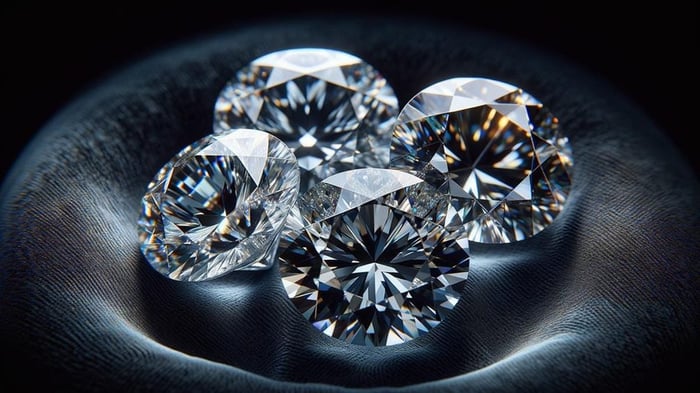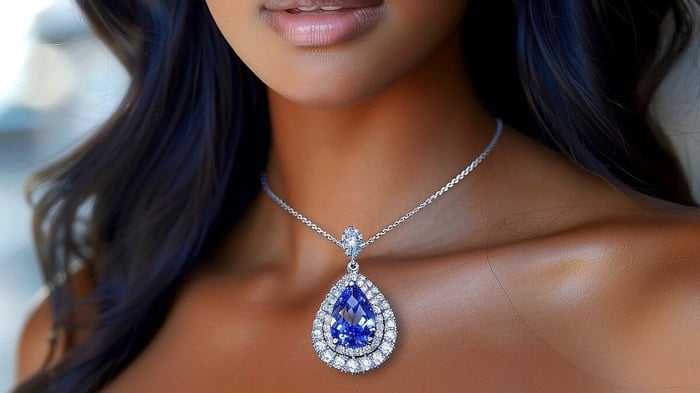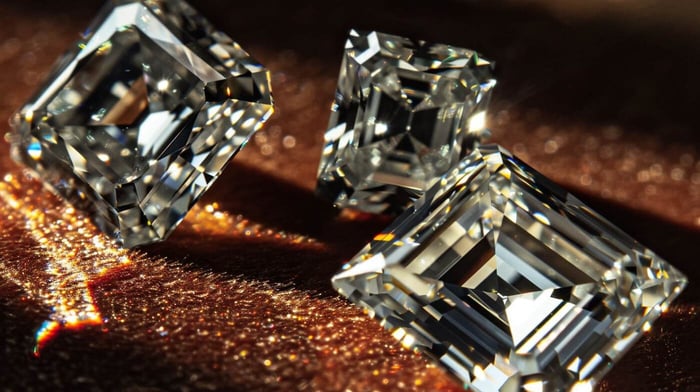Table of Contents
- Main Highlights About Diamond Setting Types
- Types of Diamond Settings
- Factors to Consider When Choosing a Diamond Setting
- Impact of Diamond Setting Types on Appearance
- Customisation and Unique Setting Designs
- Trends in Diamond Setting Types
- Choosing the Right Setting: A Step-by-Step Guide
- How to Balance Aesthetics, Practicality, and Personal Style
- All Diamond Can Offer You The Best Setting For Your New Diamond Jewellery!
Diamond settings, the intricate structures that secure and enhance the gem's brilliance, come in various styles and functions. In this article, we look at the different diamond setting types so that you can make the best choice for your next diamond jewellery purchase.
Claw settings combine elegance with practicality, including Classic Claw and V-Claw styles.
Rub-over settings, available in full or partial designs, provide a contemporary look and a secure fit.
Channel, Pavé, and Tension settings offer unique durability and added sparkle.
Halo settings amplify the centre stone's brilliance, while Flush and Bar settings deliver a modern, minimalist appeal.
These mounts significantly impact a diamond's appearance, security, and overall allure.
Continue exploring to find the perfect balance of aesthetics, functionality, and personal style in your diamond mount choice.
Main Highlights About Diamond Setting Types
- Prong Settings: Utilise metal claws to secure the diamond, combining elegance with practicality.
- Bezel Settings: Fully encase the diamond in metal, providing a modern and secure aesthetic.
- Channel Settings: Hold diamonds between metal tracks, ensuring durability and a sleek look.
- Pavé Settings: Feature small diamonds set closely together, adding extra sparkle and intricate design.
- Halo Settings: Surround the centre diamond with smaller stones, enhancing its brilliance and perceived size.
Types of Diamond Settings

Exploring the various diamond setting types reveals the artistry and precision of showcasing these precious stones. Among the most prominent options are Prong Settings, Bezel Settings, Channel Settings, Pavé Settings, and Halo Settings, each offering unique benefits and aesthetic appeal.
Understanding these settings can significantly influence one's choice, optimising the diamond's brilliance and beauty.
Prong Settings
Prong settings are renowned for their sophistication and ability to enhance a diamond's brilliance. Of all the diamond settings types, the prong, or, as it is sometimes called, claw setting, is probably the most widely used. They are available in various styles, including Classic Prong, V-Prong, and Shared Prong. Each style provides unique aesthetic and practical benefits, catering to various preferences and elevating the stone's visual attractiveness.
It is essential to grasp these distinctions when selecting a setting that enhances the diamond and the wearer's style.
Classic Fork
The classic claw setting is a timeless favourite for showcasing a diamond's brilliance. It secures the gemstone with minimal metal coverage, allowing maximum light to pass through.
This setting is versatile, often using materials like platinum and white gold for the prongs. Its sturdy design ensures the diamond remains securely in place, offering a blend of elegance and durability.
V-Prong
The V-prong setting enhances the traditional prong design by providing specialised protection for the corners of diamonds, making it particularly suitable for shapes like princess and marquise cuts. Renowned for its toughness, this setting ensures longevity while improving the jewellery's overall aesthetics.
For those exploring alternatives, bezel and channel settings offer additional choices. Nevertheless, the V-prong remains a classic option for individuals looking for both elegance and security.
Anillo de compromiso de diamantes de seis puntas certificado de calidad G/SI de 0,25 quilates en platino
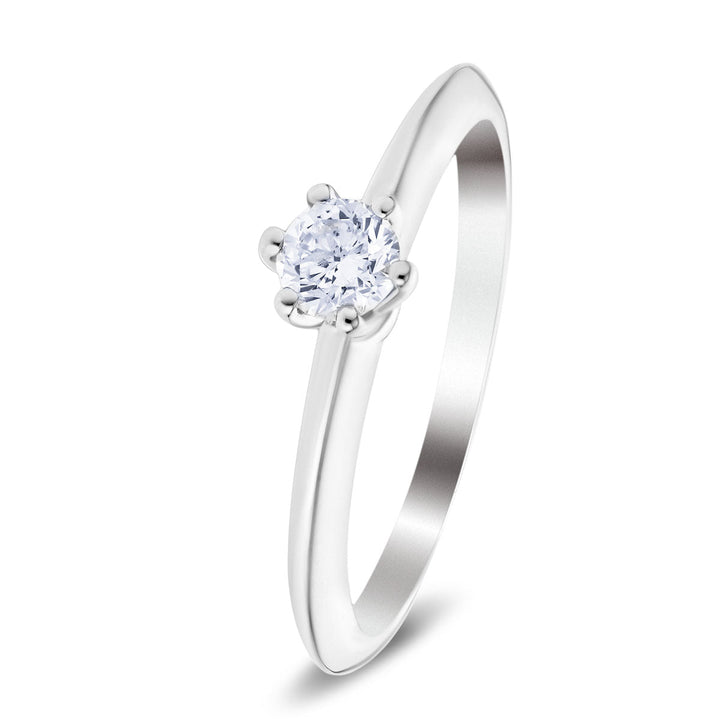
€853,95
Este es un hermoso anillo de compromiso de diamante solitario con un solo diamante brillante de talla redonda de 0,25 quilates engastado en una elegante banda de platino puro. El diamante tiene un certificado de clasificación de EDR que indica… read more
Shared Prong
The shared claw setting is a popular choice for those who want to enhance the visibility and brilliance of each diamond in a piece of jewellery.
This setting involves using shared claws to secure adjacent diamonds, maximising light exposure and creating a seamless, radiant appearance.
It appeals to those who appreciate the combination of elegance and efficiency.
Bezel Settings
Bezel settings, known for their elegance and security, encircle the gemstone with a continuous or segmented metal rim.
The diamond is completely surrounded in a full bezel setting, providing maximum protection and a sleek, modern look.
On the other hand, a partial bezel setting exposes sections of the diamond, enhancing its brilliance by allowing more light to enter while still offering a considerable degree of security.
Full Bezel
A full bezel setting encircles the diamond entirely with a metal rim, providing exceptional protection and a modern aesthetic.
Originating from ancient jewellery practices, this setting has evolved into various design variations, offering sleek and contemporary options.
The benefits include enhanced security for the diamond and a streamlined appearance, making it a preferred choice for individuals seeking elegance and durability in their jewellery.
Brazalete Tennis de Diamantes 6.14ct G/SI en Oro Amarillo 18k

€9.025,95
Las pulseras de diamantes son un estilo clásico que ha sido popular durante décadas. Tienen un atractivo atemporal que nunca pasa de moda. El oro amarillo de alta calidad significa que puede esperar un artículo de joyería que durará años.… read more
Partial Bezel
Partial bezel settings balance security and visibility by encircling only part of the diamond with a metal rim, exposing sections of the stone.
This setting has evolved to enhance both elegance and practicality. Design variations range from minimalist to ornate, catering to diverse aesthetic preferences.
Prestigious brands such as Cartier and Tiffany & Co. have embraced this style, showcasing its timeless appeal and sophistication.
Channel Settings
Channel settings, renowned for their sleek and contemporary design, securely hold diamonds between two metal tracks, creating a seamless and elegant appearance. This setting type is praised for displaying a row of diamonds without the interruption of claws, providing a clean and cohesive look.
Anillo de media eternidad con canal de talla baguette y diamantes, 0,50 ct, oro rosa de 18 k
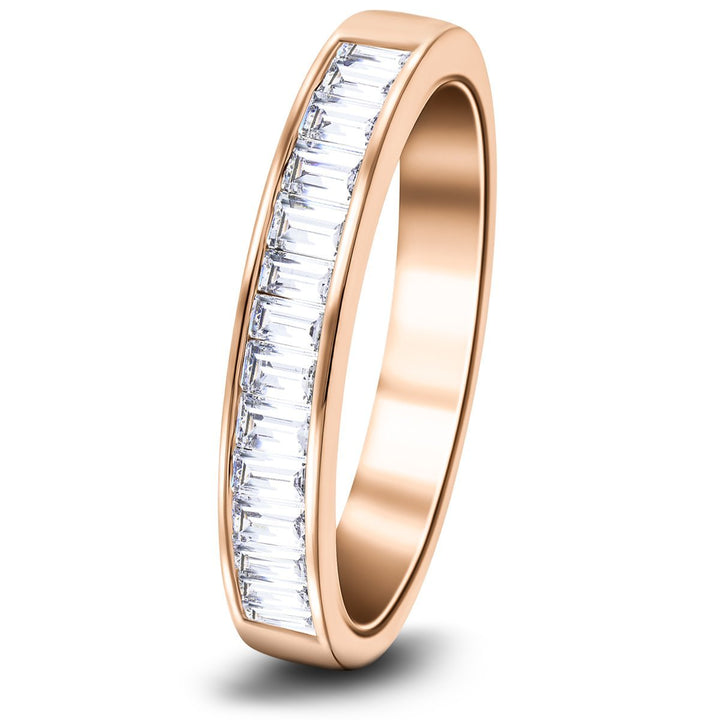
€1.154,95
Nuestros artesanos del Reino Unido elaboran hábilmente la fascinante calidez del oro rosado de 18 quilates para crear un clásico anillo de media eternidad. La llamativa belleza del anillo está coronada por medio quilate de diamantes talla baguette en un… read more
Available in various styles, channel settings cater to different preferences, from delicate to more robust designs, ensuring an option for every taste. This adaptability enhances the sense of belonging for those who appreciate unique yet timeless pieces.
One of the main advantages of channel settings is their exceptional durability. The metal tracks safeguard the diamonds from external damage and reduce the risk of losing stones, making them perfect for active lifestyles. Key benefits include:
1. Enhanced Security: Diamonds are securely held, decreasing the chances of loss.
2. Smooth Surface: The absence of claws creates a smooth, snag-free surface.
3. Versatility: Suitable for various diamond shapes and sizes.
4. Timeless Elegance: Provides a modern yet classic look that withstands trends.
Pavé Settings
Pavé settings, renowned for their sparkling elegance, involve the precise placement of small diamonds set closely together to create a continuous surface of brilliance.
Within this category, micro-pavé and French pavé stand out as distinct techniques, each offering unique aesthetic and structural attributes.
Micro-pavé features exceptionally small stones, enhancing intricacy and sparkle.
On the other hand, French pavé showcases a more intricate setting style that optimises light reflection through additional facets.
Argollas Pave de Diamantes 1.75ct Calidad G/SI en Oro Blanco 18k
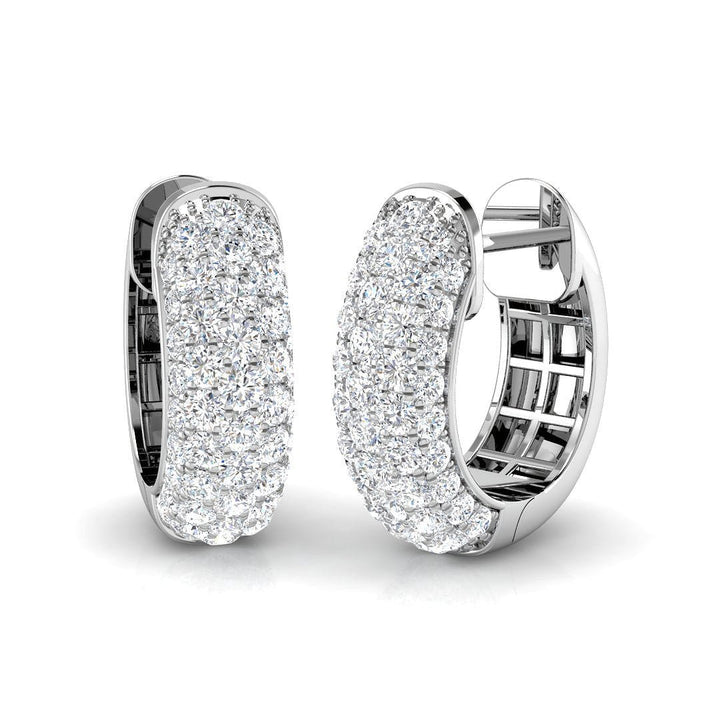
€2.370,95
Estos delicados aretes tipo argolla de diamantes para mujer están hechos a mano en oro blanco de 18 quilates y exhiben argollas de 16,0 mm de ancho engastadas con 1,75 quilates de diamantes de calidad G/SI de origen ético en… read more
Micro-Pavé
Micro-pavé settings feature numerous small diamonds meticulously set closely together, creating a continuous sparkle that amplifies the brilliance of the main stone. These settings are popular due to their intricate craftsmanship and the elegance they exude.
Key aspects include:
1. Diamond Size: Typically tiny, enhancing the main stone.
2. Craftsmanship: Requires precision.
3. Popularity: Highly sought after.
4. Elegance: Exudes sophistication.
French Pavé
The French pavé is a distinguished variation of the original pavé setting, celebrated for its unique design that enhances the visibility and brilliance of each diamond.
Originating in France, this technique has a rich history that has captivated renowned designers for centuries.
The meticulous craftsmanship and elegant aesthetics of French pavé create an exclusive allure, making it a preferred choice for those seeking sophistication and timeless beauty.
Halo Settings
Halo settings are renowned for elevating the visual impact of the centre diamond, creating a dazzling and majestic appearance.
The single halo setting encircles the central stone with a single row of smaller diamonds, enhancing its brilliance and apparent size.
For those wanting an even more luxurious look, the double halo setting features two concentric rings of diamonds, further highlighting the centrepiece and adding an additional layer of luxury.
Anillo de morganita de 0,40 ct y diamante de 0,10 ct en oro blanco de 9 quilates

€471,95
Este anillo, que tiene una piedra de morganita en el centro y un halo de diamantes brillantes en el costado, es ideal para usar con cualquier ropa y en cualquier ocasión. La morganita de talla ovalada de 0,40 quilates está… read more
Single Halo
A single halo setting showcases a central diamond surrounded by a ring of smaller diamonds, the smaller diamonds enhance the centrepiece's overall brilliance and perceived size. This design has gained popularity in engagement ring trends, and various halo styles are available to cater to different preferences.
1. Classic Round Halo: Timeless elegance.
2. Cushion Halo: Softly squared contours.
3. Vintage Halo: Intricate, heirloom-inspired designs.
4. Modern Minimalist Halo: Sleek and contemporary.
Double Halo
Double halo settings enhance the central diamond's brilliance by encircling it with two concentric rings of smaller diamonds, significantly boosting its sparkle and visual impact.
Since emerging in the early 20th century, double halo designs have maintained a lasting appeal among jewellery enthusiasts.
Today, double halo trends continue to attract those seeking a sophisticated and radiant statement piece that embodies elegance and timeless charm.
Tension Settings
Tension settings offer a sophisticated way to secure diamonds. They use the pressure from the metal band to keep the gemstone in place, giving the impression that the diamond is floating, creating a modern and captivating look. Renowned for their durability, tension settings apply significant force to firmly hold the diamond, ensuring both stability and elegance.
Choosing the right metal is essential for tension settings. Popular options include platinum, white gold, and titanium, each providing a combination of strength and visual appeal. The chosen metal significantly influences the design and lifespan of the setting.
Brazalete de diamantes en engarce de tensión Diamante G/SI de 0,33 quilates en oro amarillo de 9 k
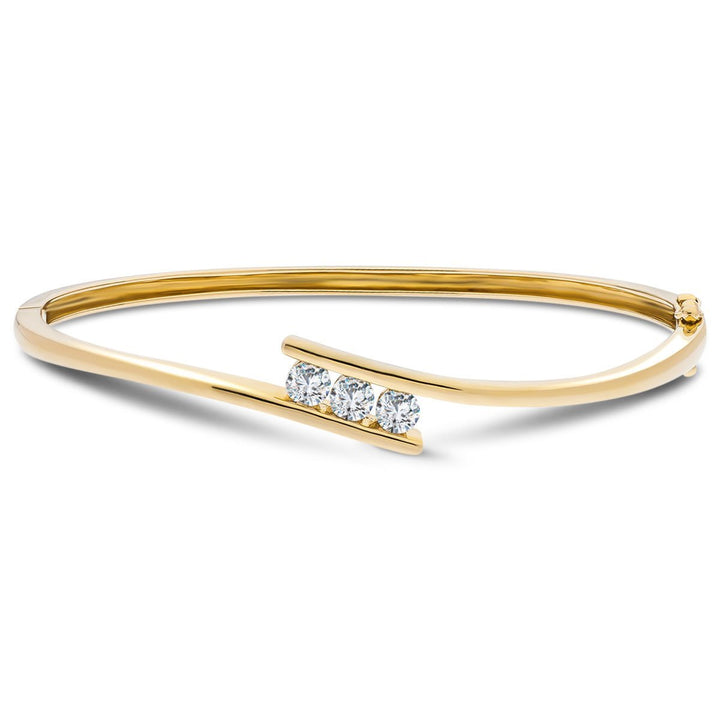
€1.697,95
Esta pieza elegante y con estilo está hecha de oro amarillo fino de 9k que es suave y pulido al tacto. Tres brillantes diamantes de calidad G/SI de origen ético están colocados en un engaste de tensión en el centro… read more
Here are four key factors to consider for tension settings:
1. Durability: The precise application of pressure makes the setting sturdy and secure for daily wear.
2. Metal Selection: Platinum, white gold, and titanium are preferred for their strength and contemporary appearance.
3. Modern Appeal: The minimalist design prominently showcases the diamond, appealing to those with a preference for modern style.
4. Customisation: Tension settings can be tailored to accommodate various diamond shapes and sizes, offering versatility in design.
This innovative setting technique is perfect for individuals who appreciate the uniqueness and sophistication of their jewellery.
Flush Settings
Flush settings provide a sleek and understated way to securely embed diamonds directly into the metal surface, creating a seamless and protective design. This setting is known for its advantages, including enhanced security for the diamond and a minimalist aesthetic that appeals to those seeking a refined yet unobtrusive look. The diamond sits level with the metal, minimising the risk of snags and damage, making it an ideal choice for active individuals.
Anillo de diamantes de princesa con juego gitano para hombre, 0,40 ct, calidad G/SI, oro amarillo de 9 quilates
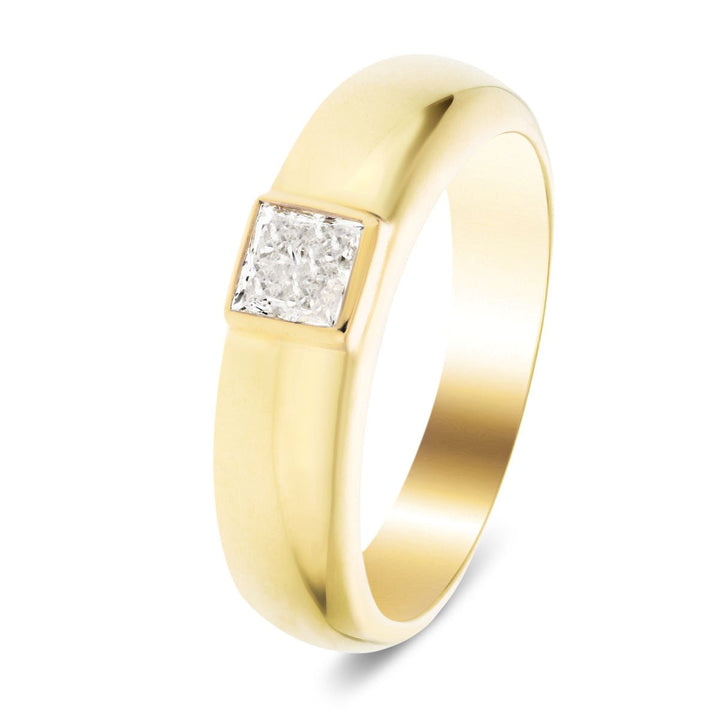
€1.269,95
Agregar descripción… read more
Design options for flush settings are diverse, ranging from simple solitaires to intricate patterns where multiple smaller diamonds are embedded to create a sparkling mosaic effect. This versatility allows for unique personalisation, catering to various tastes and preferences. Flush settings can be incorporated into various jewellery, including rings, bracelets, and even watches, showcasing adaptability across different adornments.
Flush settings are particularly favoured in wedding bands and engagement rings, where durability and subtle elegance are paramount. They are also prevalent in men's jewellery, where the understated look aligns with a more masculine aesthetic.
Bar Settings
Bar settings are a distinctive type of diamond setting featuring vertical metal bars that securely hold the diamond in place while allowing maximum light to pass through. Emerging during the Art Deco period, bar settings gained popularity for their sleek, modern aesthetic and structural integrity, offering a sophisticated alternative to more traditional settings.
Anillo de media eternidad con diamantes engastados en barra, diamantes G/SI de 0,75 quilates, oro amarillo de 18 k
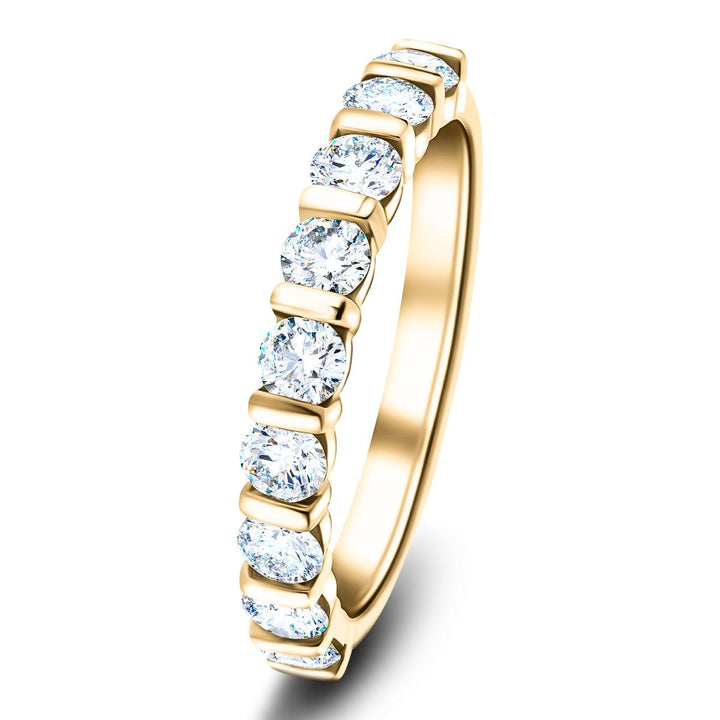
€1.177,95
Este anillo de media eternidad tiene una apariencia llamativa y distintiva, utilizando tres cuartos de quilate de diamantes de origen ético para lograr un efecto notable. Los engastes de la barra en oro amarillo de 18k elevan esta pieza a… read more
Historically, bar settings have been favoured for creating elegant, streamlined jewellery designs. Their ability to showcase the diamond's brilliance while providing a secure hold made them a preferred choice among jewellers seeking both beauty and functionality.
Cluster Settings
Cluster settings are a popular type of diamond setting that feature multiple smaller diamonds arranged closely together to create the illusion of a larger, more radiant centrepiece. This setting style has historical origins dating back to the Georgian and Victorian periods, when the brilliance of multiple stones was highly valued for its grandeur.
Numerous design variations exist in cluster settings, ranging from simple floral motifs to elaborate patterns, each bringing a unique aesthetic to the jewellery piece. These versatile settings are often chosen to amplify the visual impact of engagement rings, pendants, and earrings, appealing to those who appreciate timeless elegance and sophistication.
Collar con colgante de racimo de diamantes con margaritas 1,50 ct G/SI oro blanco de 18 k

€3.445,95
Exprese sus verdaderos sentimientos e intenciones con este hermoso collar con colgante de racimo de diamantes hecho a mano en oro blanco de 18k. El colgante está elaborado con oro blanco de 18k. Presenta un diseño de margarita con un… read more
Crafting cluster settings requires meticulous craftsmanship to secure the smaller diamonds while maximising their collective brilliance. Jewellers often use prongs, beads, or bezel settings to hold each diamond securely, creating a seamless and cohesive design. The artistry involved in such settings enhances the overall appearance and speaks to the wearer's appreciation for intricate, well-crafted jewellery.
Invisible Settings
Invisible settings, renowned for their seamless and contemporary appearance, are a sophisticated type of diamond setting where the stones are meticulously positioned side by side without visible metal holding them in place. This technique allows for an uninterrupted surface of brilliance, enhancing the overall appeal of the jewellery.
The 1930s saw significant advancements in jewellery settings, which is when invisible settings first appeared. Master jewellers pioneered this technique to create a refined look highlighting the diamonds rather than the metal frame. Over the years, this setting has evolved, incorporating advanced methods to improve durability and aesthetic appeal.
Channel Set Trilogy Crossover Anillo 0.33ct Calidad G/SI Oro Blanco 18k
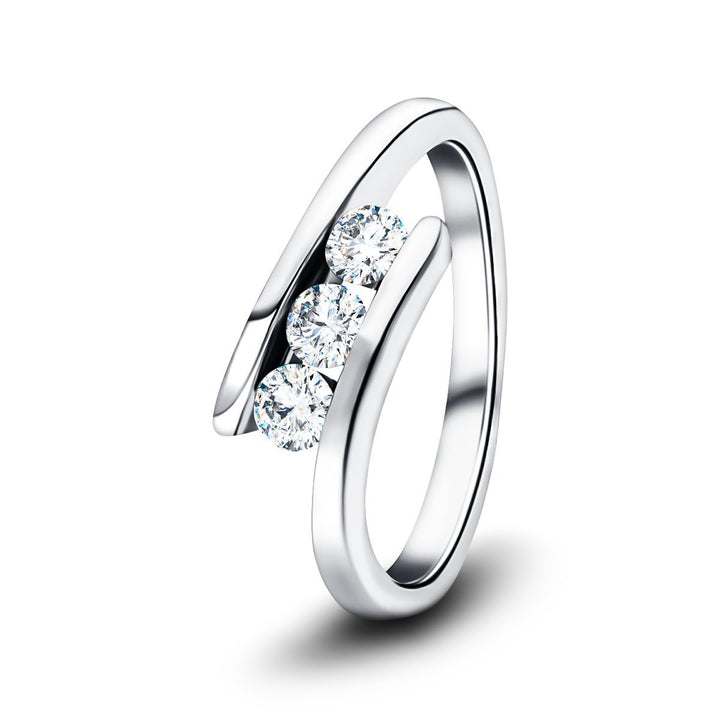
€1.026,95
Este anillo trilogía de diamantes en oro blanco de 18 quilates está diseñado y fabricado a mano en el Reino Unido. El anillo presenta tres diamantes con un total de 0.33CT. Cada diamante es de calidad G/SI y de origen… read more
Notable examples of invisible settings can be seen in the collections of prestigious brands such as Van Cleef & Arpels, who popularised this style with their intricate and elegant designs. Invisible settings are particularly favoured in high-end pieces, where the craftsmanship and precision required reflect the exclusivity and luxury desired by discerning enthusiasts.
Key features of invisible settings include:
1. Enhanced Brilliance: Maximum light reflection due to minimal metal visibility.
2. Sleek Surface: A smooth, modern look without prongs or bezels.
3. Intricate Craftsmanship: Demands expert skill and precision.
4. Luxury Appeal: Often featured in high-end jewellery collections.
Factors to Consider When Choosing a Diamond Setting

Multiple factors influence the ideal setting for your diamond's aesthetic appeal and functionality. Considerations such as diamond shape compatibility, lifestyle practicality, and maintenance requirements ensure the piece remains exquisite and durable for daily wear.
Additionally, budget considerations are crucial, guiding you to choose settings that balance elegance with financial sensibility.
Diamond Shape Compatibility
Selecting the appropriate setting for a diamond requires careful consideration of the stone's shape to ensure both aesthetic appeal and structural security. Shape compatibility is crucial; an unsuitable setting can diminish the diamond's brilliance and compromise its stability.
When choosing a setting, several factors should be evaluated:
1. Stone Stability: Shapes with pointed ends, such as marquise or pear, are more vulnerable to damage and may benefit from protective settings like bezel or halo to ensure longevity.
2. Metal Preference: The choice of metal can enhance the diamond shape's appearance. For instance, platinum or white gold settings accentuate the crisp lines of an emerald cut, while yellow gold can enhance the warmth of a cushion cut.
3. Prong Placement: The arrangement and number of prongs should be tailored to the diamond shape for optimal security. Round diamonds typically suit four or six-prong settings, whereas princess cuts might require V-shaped prongs to safeguard their corners.
4. Symmetry and Proportion: The setting should balance the diamond's proportions, ensuring symmetry and harmony. A well-matched setting highlights the stone's unique facets, creating a cohesive and visually appealing piece.
Understanding these considerations fosters an appreciation for the intricate craftsmanship of fine jewellery.
Lifestyle and Practicality
Evaluating one's daily activities and personal habits is essential when you are considering diamond setting types. Lifestyle preferences significantly influence the best setting choice. An active individual may need a more secure and durable setting, such as a bezel or channel setting, to prevent damage.
Conversely, those with a more sedentary lifestyle might favour the elegance of a prong or cathedral setting, which enhances the diamond's brilliance.
Practical considerations go beyond aesthetics. A low-profile setting can reduce the risk of snagging or loss for those in hands-on professions or hobbies. It's also important to consider the frequency of wear. For everyday use, settings that balance beauty and durability, like the tension or bar setting, are ideal.
Settings for special occasions might prioritise intricate designs and fashion trends that reflect contemporary elegance. Fashion trends, which are constantly changing, also influence setting choices. Current trends lean towards minimalist designs, favouring sleek and simple settings that allow the diamond to take centre stage.
Staying updated with these trends ensures that your choice fits your lifestyle and remains timelessly chic.
Maintenance Requirements
Understanding the maintenance requirements of various diamond setting types is crucial for preserving their beauty and longevity. Each type of setting requires specific care to ensure the diamond remains secure and radiant over time. By recognising these needs, you can make an informed decision that suits your lifestyle and desire for enduring sparkle.
1. Cleaning Frequency: Prong settings highlighting the diamond's brilliance often need more frequent cleaning due to their intricate design. In contrast, bezel settings encase the diamond, offering protection from dirt and reducing the need for constant cleaning.
2. Inspection Routine: Regular inspections are essential, especially for settings like pavé or channel, where multiple small diamonds are held in place. Checking for loose stones or worn prongs can prevent costly repairs and potential loss.
3. Professional Servicing: To maintain the setting's integrity, annual visits to a professional jeweller are recommended for deep cleaning, prong tightening, and overall assessments.
4. Daily Care Practices: Gentle handling, avoiding harsh chemicals, and proper storage of your diamond jewellery can minimise wear and tear and prolong the life of your treasured piece.
Budget Considerations
When selecting a diamond setting, budget considerations are crucial in balancing aesthetic appeal and financial feasibility. The variety of choices can be overwhelming, but understanding affordable alternatives can simplify the decision-making process.
Opting for budget-friendly metals such as sterling silver, white gold, or palladium can significantly reduce costs without sacrificing elegance. These metals offer a sophisticated look and durability.
For those desiring the allure of a diamond without the high cost, diamond simulants like cubic zirconia and moissanite are excellent options. These alternatives closely mimic the brilliance and sparkle of natural diamonds, providing a similar appearance at a fraction of the price.
Additionally, choosing settings with fewer prongs or simpler designs can be more economical, as they reduce labour and material costs.
It's essential to consider the piece's long-term value and emotional significance. By carefully evaluating budget constraints and exploring alternative options, one can find a setting that aligns with personal taste and financial constraints, ensuring that the chosen piece remains cherished for years to come.
Impact of Diamond Setting Types on Appearance
The choice of setting is crucial in enhancing a diamond's appearance. It influences its light performance, brilliance, perceived size, proportions, and colour presentation.
Different diamond setting types can either enhance a diamond's ability to capture and reflect light or diminish its sparkle.
Additionally, the right setting can create the illusion of a larger stone and subtly enhance or mask the diamond's inherent colour, significantly impacting its overall aesthetic appeal.
Light Performance and Brilliance
Diamond settings significantly impact light performance and brilliance, influencing the overall appearance of the gem. The setting dictates how light interacts with the diamond, affecting reflection, brilliance, and sparkle. A well-chosen setting can enhance these qualities, creating a captivating light display.
1. Prong Setting: This traditional setting raises the diamond to maximise light exposure. Typically, four or six prongs securely hold the diamond while allowing light to enter from different angles, intensifying its sparkle.
2. Bezel Setting: This setting surrounds the diamond with a thin metal rim, providing a contemporary look and protection. Although it slightly restricts light entry, it offers a sleek, continuous brilliance.
3. Pavé Setting: Small diamonds are closely set together with minimal visible metal, forming a sparkling surface. This setting boosts the central diamond's brilliance by reflecting light from the smaller stones.
4. Channel Setting: Diamonds are placed between two metal channels for a secure fit. This setting enables light to bounce off the stones' surfaces, contributing to a refined, understated brilliance.
Understanding these settings helps make informed choices, ensuring the diamond's radiance is fully appreciated.
Perceived Size and Proportions
Beyond enhancing light performance and brilliance, diamond settings significantly influence the gem's perceived size and proportions. The choice of setting can create an optical illusion, making the diamond appear larger or more proportionate than its actual dimensions.
The strategic use of coloured metals, such as white gold or platinum, enhances the diamond's appearance, providing a stark contrast that magnifies its visual dimensions. Such settings uplift the stone's elegance and foster a sense of exclusivity among discerning connoisseurs.
The right setting can transform even modest diamonds into spectacular focal points, demonstrating the profound impact of setting choices on perceived size and proportions.
The choice of setting can significantly influence the gem's perceived size and proportions. For instance, a halo setting, where smaller diamonds encircle the central stone, amplifies the visual impact by augmenting the diamond's perceived brilliance and general size.
Prong settings, especially those with minimal metal visibility, allow more light to enter the diamond, enhancing its sparkle and creating a more substantial visual presence. Bezel settings encase the diamond in a continuous metal rim, giving the gem a more robust and defined look, often making it seem more substantial despite sometimes reducing its perceived brilliance.
Colour Enhancement or Masking
Understanding how settings can enhance or mask a diamond's colour is crucial for optimising its visual appeal. How a diamond is set can significantly influence its perceived colour, enhancing or diminishing its natural hue. Accurate colour grading is essential to this process, highlighting the diamond's true quality.
Prong Settings: These settings allow maximum light to enter the diamond, showcasing its true colour. They are ideal for high-colour grade diamonds but may reveal any colour imperfections.
Bezel Settings: By surrounding the diamond with metal, bezel settings can mask lower colour grades. This type of setting is excellent for diamonds with slight colour tints, as it can create an illusion of a higher colour grade.
Halo Settings: Encircling the central diamond with smaller stones, halo settings can enhance the overall appearance and colour of the main diamond. This setting is particularly effective for synthetic diamonds and treated gems to heighten their visual impact.
Channel Settings: Often used for smaller diamonds, channel settings create a continuous flow of brilliance, subtly masking minor colour inconsistencies.
Understanding these settings is essential for anyone who values their diamond's aesthetic and intrinsic qualities, ensuring it shines with unparalleled elegance.
Customisation and Unique Setting Designs

Explore the world of diamond settings, which skillfully combine individual preferences with creativity. Designs range from vintage-inspired to modern minimalism.
Incorporating mixed metals can create a striking juxtaposition, while nature-inspired settings evoke a feeling of natural elegance.
This section delves into these varied design options, showcasing how they contribute to each piece's distinctiveness.
Vintage-Inspired Settings
Vintage-inspired settings offer timeless charm and customisation, reflecting unique personal tastes and historical influences. They capture an era when craftsmanship and intricate designs were paramount.
Here are four prominent styles that encapsulate this vintage allure:
1. Art Deco: Known for geometric shapes, bold lines, and vivid contrasts, Art Deco settings bring avant-garde sophistication to diamond jewellery. This style suits those who appreciate modernity with a historical twist.
2. Edwardian Elegance: Renowned for delicate filigree work and the use of platinum, the Edwardian period embodies grace and refinement. Diamonds set in these intricate designs appear almost ethereal, ideal for lovers of understated luxury.
3. Victorian Motifs: Rich in symbolism and romance, Victorian settings often feature floral patterns, hearts, and intricate engravings. This style appeals to those who cherish sentimental and ornate jewellery that tells a story.
4. Retro Glamour: Post-World War II, the Retro period introduced bold, oversized designs emphasising curves and colourful gemstones. These settings are perfect for those who revel in vintage glamour with a dramatic flair.
Modern and Minimalist Settings
While vintage-inspired settings evoke intricate charm, modern and minimalist settings focus on sleek simplicity and contemporary elegance. Clean lines and understated beauty are features of these designs, which appeal to those who value a refined aesthetic. Geometric shapes like hexagons or squares often feature prominently, adding a contemporary edge to traditional diamond settings.
Minimalist engagement rings emphasise the diamond itself, typically showcasing it in a solitaire setting with a thin band. This style highlights the gemstone's natural brilliance and aligns with the trend towards simplicity and sophistication. The absence of extraneous elements allows the diamond to take centre stage, creating a timeless and modern look.
Customisation in minimalist settings offers unique opportunities for personal expression. Clients can choose from various metal finishes, band widths, and diamond cuts to create a piece that resonates with their individual style. Whether opting for a bezel setting that encases the diamond in a sleek metal frame or a tension setting that gives the illusion of a floating gem, these designs cater to those seeking a distinctive yet elegant piece of jewellery.
Mixed Metal Settings
How can the allure of mixed metal settings transform a diamond piece into a unique expression of personal style?
The exquisite art of combining different metals—such as gold, platinum, and rose gold—elevates diamond jewellery into realms of personal significance and aesthetic distinction. By expertly blending these alloys, designers craft pieces that resonate with individuality and elegance, appealing to those who seek to stand out within a discerning community.
Mixed metal settings offer a sophisticated interplay of contrasting metals, resulting in visually striking and harmonious designs. This technique enhances the diamond's brilliance and provides a canvas for creative expression. Here are four distinctive benefits of mixed metal settings:
1. Enhanced Contrast: The juxtaposition of different metals accentuates the diamond's sparkle, creating a captivating visual effect.
2. Customisation: Various alloy combinations allow for personalised designs that reflect unique tastes and preferences.
3. Durability: Combining metals can improve the jewellery's longevity and robustness.
4. Versatility: Metal blending enables the creation of adaptable pieces that complement different styles and occasions.
Nature-Inspired Settings
Nature-inspired settings are based on the intricacy of mixed metal designs, providing a captivating way to personalise diamond jewellery with motifs and textures taken from the natural world. These distinctive settings evoke a feeling of organic elegance, establishing a profound connection with the wearer that goes beyond mere aesthetics.
Organic elements are seamlessly incorporated into these settings, exuding an air of authenticity and timeless beauty. For example, detailed floral designs capture the delicate essence of blossoming flowers, symbolising growth and renewal. Each petal and leaf is crafted meticulously, often including milgrain edges or pavé-set diamonds to enhance the overall charm.
Furthermore, nature-inspired settings offer exceptional customisation. Customers can select specific flora or fauna that hold personal significance, ensuring that each piece becomes a cherished symbol of individuality**. This bespoke approach encourages a sense of exclusivity, appealing to those who desire more than just decoration, but a meaningful and lasting connection with their jewellery.
Trends in Diamond Setting Types

As diamond settings continue to evolve, staying updated on trends that merge timeless elegance with modern innovation is crucial. Celebrity preferences often lead the way, influencing public tastes and setting the stage for what's popular. The rise in popularity of intricate halo settings, favoured by many Hollywood stars, exemplifies this trend. These settings enhance the centre stone's brilliance and add a layer of sophistication that appeals to a broad audience.
Seasonal trends also shape jewellery buyers' choices of diamond setting types. During spring and summer, lighter and more delicate designs dominate, reflecting these seasons' airy and fresh ambience. In contrast, autumn and winter bring preferences for more robust and intricate designs, mirroring the richness and depth of the colder months.
Cultural influences significantly impact diamond settings, with global motifs and traditional craftsmanship gaining attention. The resurgence of vintage-inspired settings, reminiscent of Victorian and Art Deco periods, speaks to a collective yearning for nostalgia and heritage. These converging trends create a dynamic and evolving landscape, catering to diverse tastes while maintaining the timeless allure of diamond jewellery.
Choosing the Right Setting: A Step-by-Step Guide

Determine Ring Size: Ensuring a perfect fit is crucial. An ill-fitting ring can detract from the setting's beauty and pose a risk to the diamond's security.
Select Metal Type: The metal type significantly influences aesthetics and durability. Popular choices include platinum, known for its resilience, and gold, available in yellow, white, and rose hues.
Evaluate Setting Durability: Your lifestyle impacts the setting's robustness. If you lead an active life, consider durable settings like bezel or tension, which offer added protection for the diamond.
Match with Personal Style: The setting should reflect your unique taste. Classic solitaire, vintage-inspired halo, and contemporary three-stone designs each convey distinct aesthetics and values.
How to Balance Aesthetics, Practicality, and Personal Style

Balancing aesthetics, practicality, and personal style is essential when selecting the perfect diamond setting to ensure it meets both visual appeal and everyday functionality. The evolution of diamond settings reveals a fascinating journey, from simple bezel enclosures to intricate pavé designs, each reflecting the cultural trends and technological advancements of their time.
A Gemological Institute of America survey found that 70% of consumers prioritise setting design over diamond size. This statistic underscores the importance of choosing a setting that aligns with personal style while ensuring durability.
Different diamond setting types can significantly influence a diamond's appearance and usability. For instance, prong settings maximise brilliance, while bezel settings offer security and a sleek look. Each setting caters to specific practical needs, whether for daily wear or special occasions.
Cultural influences also shape diamond setting preferences. For example, while the solitaire setting is globally admired for its simplicity and elegance, different regions may have unique traditional preferences that affect design choices.
Ultimately, the ideal diamond setting harmonises aesthetic appeal, functional durability, and personal significance. By thoughtfully considering these elements, one can choose a setting that not only captivates the eye but also seamlessly fits with individual lifestyles and cultural values.
All Diamond Can Offer You The Best Setting For Your New Diamond Jewellery!
Our British designers and artisans use a wide range of diamond setting types to suit each diamond and each piece of jewellery. All of our diamond jewellery is made with natural mined diamonds created over millions of years. To assure you of a lifetime of satisfaction, we offer a lifetime workmanship guarantee on every item of jewellery that we sell.
Please take a moment to browse our collections of fine diamond jewellery. We are proud of the work of our entire team, and we think you will be equally proud to wear the jewellery we make for you. Please do not hesitate to contact us to discuss your planned purchase using our live chat system available on each page of our store at All Diamond.

